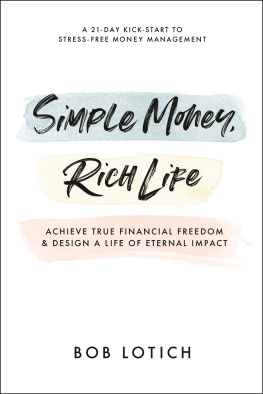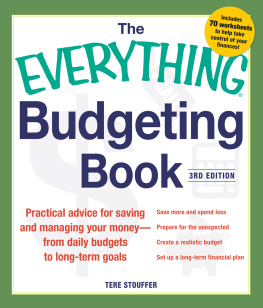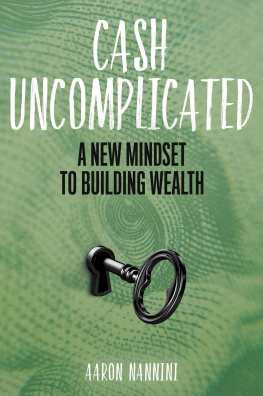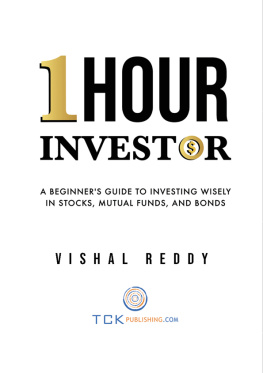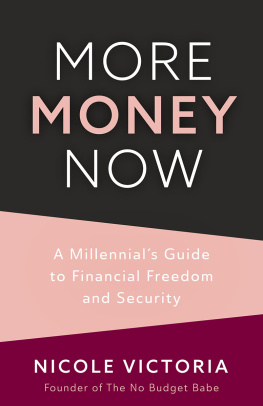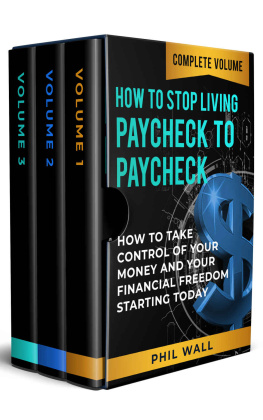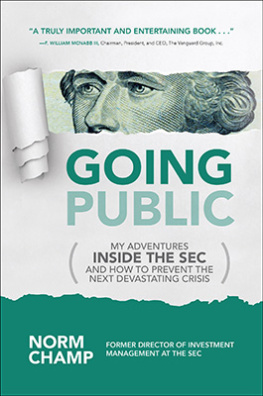WEALTH
HAPPENS
ONE DAY
AT A TIME
365 Days to a Brighter Financial Future
Brooke M. Stephens

CONTENTS
A FEW YEARS AGO, I BEGAN THE HABIT OF MEETING WEEKLY WITH A friend for lunch and good conversation. We would often move on to a couple of hours of boutique browsing. To me, browsing is one step removed from window shopping: you look, feel, try on, play with, fantasize, and then put it back. Not for my friend. Invariably, she had to buy something. A scarf. A hat. Shoes. A dress. I rarely bought anything, which annoyed her greatly. One Sunday afternoon, in an antique jewelry shop, my friend insisted that I had to buy the onyx and silver earrings that I admired. For $75.00. I laughed and explained that I lose too many earrings and had much better things to do with $75.00. With a determined look in her eye, she wouldnt let me get away with that and solicited the interest of the salesclerk to pressure me.
Name something you can do with $75.00 that would be better than treating yourself to something you obviously enjoy? my friend smirked with an intense, challenging gaze. Now was my chance to make an unforgettable point that I hoped would help her confront her own fragile financial life. What you see is a pair of earrings for $75.00, I said. I see the cost of three shares of a utility stock Ive been studying, which is now selling for $25.00 a share and which will pay me a 7% dividend. The stock will go up and the dividends will keep paying me income long after Ive lost those earrings. My friend and the saleswoman looked at me in stunned silence.
How did you ever do that to your mind? she whispered. I could never learn to think like that!
Yes, you can, if you want to.
Over the next few months when we met for lunch, I gave my friend little anecdotes, news clips, affirmations, stories, and examples of how to become more financially aware of the way money worked in her life. She labeled me her money coach. A quick two- or three-minute explanation of a financial idea was all she could handleespecially on a topic that stirred up in her so many feelings of insecurity, uncertainty, and intimidation. After a few weeks, she began asking questions and looking forward to her wealth notes, as she called them, that I would give her at each meeting. Eventually she began to act on them. She started to watch her spending, she planned a budget, organized her records, read some financial news, and bought health insurance. She had clarified her goals and started making a schedule for herself to conquer her debts and slowly examine her fears and resistance to investing. As she became more comfortable with the world of money, she started investing in mutual funds, and now she considers herself a pro at following the news on CNBC. She subscribes to several personal finance publications and has gotten a group of friends to start an investment club!
This book is the compilation of many of the short notes and examples I used to begin making her aware of how she could become financially comfortable even with a few dollars a month and the right attitude. Consider these daily pages to be little kernels of financial wisdom to be planted in your thinking process in order to point you in the right direction. This is the same three-minute-money-message approach that I used years later as a personal finance spokesperson on FXs Breakfast Time show. Three minutes a day is all it takes to read a days entry here. Guidance, simple directives and down-to-earth, cut-to-the-chase types of information for busy people who need to know what to do but who dont have a whole lot of time to devote to finding the answers.
The book is divided into five sections.
Part One, Wealth Consciousness, addresses how you think, feel, and behave with money. The money messages from your childhood and your social environment color all your choices. Resistance, avoidance, and self-sabotage are all learned behaviors that can be changed with effort. Once you get in touch with some of these feelings and deal with them properly, this book guides you through several steps that help you begin to reshape your thinking about money and to create a financial plan. Simple guidelines are offered for layingout goals and setting a timetable for getting what matters to you with the money you have. The process of opening an investment account, filling out the forms, signing the checks, and putting money into a mutual fund account takes about fifteen minutes. Yet when youre stuck in some of the old fears, habits, and self-defeating patterns that keep getting in your way, it can take fifteen years to get past themif you ever do. This book is designed to help you break through the old patterns, sweep them out like the life-cluttering debris that they are, and move on to a brighter financial future. You wont know youre happy unless you define what it will take to make you happy. Setting goals is how you define some of the steps you want to take to know you have arrived there. First you have to believe that its possible for you to get there.
Part Two, Wealth Foundation, addresses the nuts and bolts of getting started: doing a budget or a spending plan, dealing with issues of credit and debtcleaning up mistakes and making clear choices in the futureand finding out where to get help with financial problems. In short, this chapter deals with saving money, teaching you how to do it, and where in your life to turn in order to begin. Building a cushion for financial emergencies is the foundation that has to be established before taking on the bigger choices of risking money in the world of investing.
Part Three, Wealth Creation, is the longest section of the book and requires the most time. It focuses on learning about building longterm assets, such as a home, and opening investment accounts to reach those goals. Investment recommendations of mutual funds are based on research provided from various financial publications, investment literature, and sources on the Internet. All fall into the $l,000-or-less category for the small investor who is totally new to the idea and doesnt want to take a great deal of risk. Individual stocks and brokerage firms are discussed and suggested as a means for guiding the average new investor through the maze of investment choices. Simple definitions are offered that avoid the jargon that frequently confuses and intimidates novice investors. The largest and most important investment choice, buying a home, is covered in detail in this section.
Part Four, Wealth Protection, offers a basic introduction to what you should know about buying all forms of insurance and protecting the assets you are accumulating in the wealth-building process. After the sweat and effort that goes into accumulating assets, the wisest move for a financially savvy person is to protect what you have from possible loss wherever its reasonable to do so. These simple suggestions will cut to the bottom line of how it should be done, with the least amount of aggravation if you choose to buy insurance on your own, or with the confidence of a knowledgeable buyer if you choose to work with an insurance agent.
Part Five, Wealth Preservation, covers the issues of retirement and estate planning. Who said that retirement was the end of life? Its the next phase when you get to enjoy all you have earned and accumulated from investments. This is also the time of life when you think about whether you want to spend your childrens inheritance on the beach house in the Bahamas or leave an intact estate to your grandchildren.
How to use this book is up to you.
Whether its a New Years resolution, a milestone birthday, a new job, or a new life situation like marriage, divorce, or the birth of a child, you know that you could be doing a better job or managing your moneybut you dont have the time!



